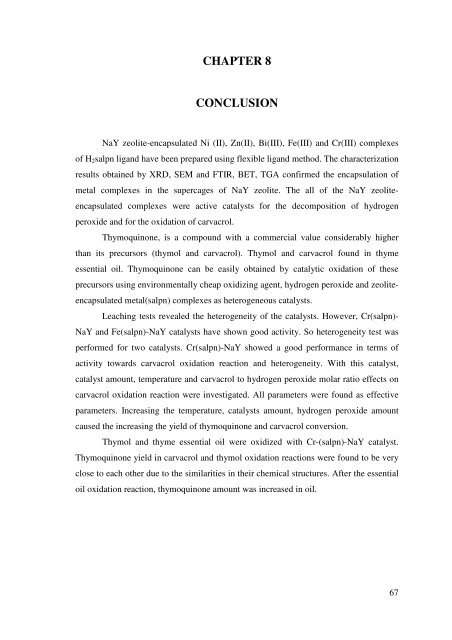the production of thymoquinone from thymol and carvacrol
the production of thymoquinone from thymol and carvacrol
the production of thymoquinone from thymol and carvacrol
You also want an ePaper? Increase the reach of your titles
YUMPU automatically turns print PDFs into web optimized ePapers that Google loves.
CHAPTER 8<br />
CONCLUSION<br />
NaY zeolite-encapsulated Ni (II), Zn(II), Bi(III), Fe(III) <strong>and</strong> Cr(III) complexes<br />
<strong>of</strong> H2salpn lig<strong>and</strong> have been prepared using flexible lig<strong>and</strong> method. The characterization<br />
results obtained by XRD, SEM <strong>and</strong> FTIR, BET, TGA confirmed <strong>the</strong> encapsulation <strong>of</strong><br />
metal complexes in <strong>the</strong> supercages <strong>of</strong> NaY zeolite. The all <strong>of</strong> <strong>the</strong> NaY zeolite-<br />
encapsulated complexes were active catalysts for <strong>the</strong> decomposition <strong>of</strong> hydrogen<br />
peroxide <strong>and</strong> for <strong>the</strong> oxidation <strong>of</strong> <strong>carvacrol</strong>.<br />
Thymoquinone, is a compound with a commercial value considerably higher<br />
than its precursors (<strong>thymol</strong> <strong>and</strong> <strong>carvacrol</strong>). Thymol <strong>and</strong> <strong>carvacrol</strong> found in thyme<br />
essential oil. Thymoquinone can be easily obtained by catalytic oxidation <strong>of</strong> <strong>the</strong>se<br />
precursors using environmentally cheap oxidizing agent, hydrogen peroxide <strong>and</strong> zeolite-<br />
encapsulated metal(salpn) complexes as heterogeneous catalysts.<br />
Leaching tests revealed <strong>the</strong> heterogeneity <strong>of</strong> <strong>the</strong> catalysts. However, Cr(salpn)-<br />
NaY <strong>and</strong> Fe(salpn)-NaY catalysts have shown good activity. So heterogeneity test was<br />
performed for two catalysts. Cr(salpn)-NaY showed a good performance in terms <strong>of</strong><br />
activity towards <strong>carvacrol</strong> oxidation reaction <strong>and</strong> heterogeneity. With this catalyst,<br />
catalyst amount, temperature <strong>and</strong> <strong>carvacrol</strong> to hydrogen peroxide molar ratio effects on<br />
<strong>carvacrol</strong> oxidation reaction were investigated. All parameters were found as effective<br />
parameters. Increasing <strong>the</strong> temperature, catalysts amount, hydrogen peroxide amount<br />
caused <strong>the</strong> increasing <strong>the</strong> yield <strong>of</strong> <strong>thymoquinone</strong> <strong>and</strong> <strong>carvacrol</strong> conversion.<br />
Thymol <strong>and</strong> thyme essential oil were oxidized with Cr-(salpn)-NaY catalyst.<br />
Thymoquinone yield in <strong>carvacrol</strong> <strong>and</strong> <strong>thymol</strong> oxidation reactions were found to be very<br />
close to each o<strong>the</strong>r due to <strong>the</strong> similarities in <strong>the</strong>ir chemical structures. After <strong>the</strong> essential<br />
oil oxidation reaction, <strong>thymoquinone</strong> amount was increased in oil.<br />
67
















